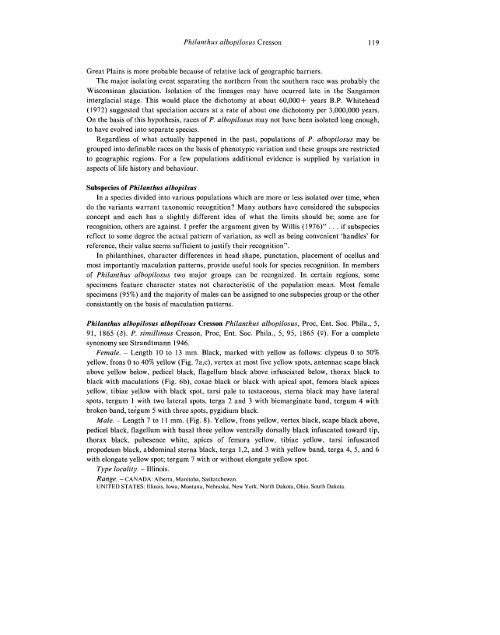Hilchie 1982 QEv18n1_4 91_126 CC released.pdf - College of ...
Hilchie 1982 QEv18n1_4 91_126 CC released.pdf - College of ...
Hilchie 1982 QEv18n1_4 91_126 CC released.pdf - College of ...
Create successful ePaper yourself
Turn your PDF publications into a flip-book with our unique Google optimized e-Paper software.
Philanthus albopilosus Cresson 119<br />
Great Plains is more probable because <strong>of</strong> relative lack <strong>of</strong> geographic barriers.<br />
The major isolating event separating the northern from the southern race was probably the<br />
Wisconsinan glaciation. Isolation <strong>of</strong> the lineages may have ocurred late in the Sangamon<br />
interglacial stage. This would place the dichotomy at about 60,000+ years B.P. Whitehead<br />
(1972) suggested that speciation occurs at a rate <strong>of</strong> about one dichotomy per 3,000,000 years.<br />
On the basis <strong>of</strong> this hypothesis, races <strong>of</strong> P. albopilosus may not have been isolated long enough,<br />
to have evolved into separate species.<br />
Regardless <strong>of</strong> what actually happened in the past, populations <strong>of</strong> P. albopilosus may be<br />
grouped into definable races on the basis <strong>of</strong> phenotypic variation and these groups are restricted<br />
to geographic regions. For a few populations additional evidence is supplied by variation in<br />
aspects <strong>of</strong> life history and behaviour.<br />
Subspecies <strong>of</strong> Philanthus albopilsus<br />
In a species divided into various populations which are more or less isolated over time, when<br />
do the variants warrant taxonomic recognition? Many authors have considered the subspecies<br />
concept and each has a slightly different idea <strong>of</strong> what the limits should be; some are for<br />
recognition, others are against. I prefer the argument given by Willis (1976)" ... if subspecies<br />
reflect to some degree the actual pattern <strong>of</strong> variation, as well as being convenient 'handles' for<br />
reference, their value seems sufficient to justify their recognition".<br />
In philanthines, character differences in head shape, punctation, placement <strong>of</strong> ocellus and<br />
most importantly maculation patterns, provide useful tools for species recognition. In members<br />
<strong>of</strong> Philanthus albopilosus two major groups can be recognized. In certain regions, some<br />
specimens feature character states not characteristic <strong>of</strong> the population mean. Most female<br />
specimens (95%) and the majority <strong>of</strong> males can be assigned to one subspecies group or the other<br />
consistantly on the basis <strong>of</strong> maculation patterns.<br />
Philanthus albopilosus albopilosus Cresson Philanthus albopilosus, Proc, Ent. Soc. Phila., 5,<br />
<strong>91</strong>, 1865 (
















